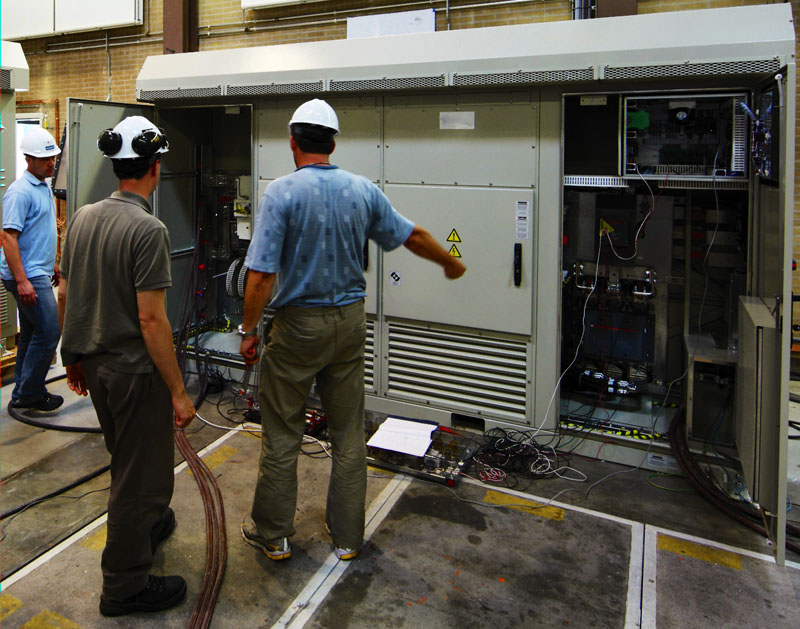Author:
Erik de Jong, Managing Director, Flex Power Grid Laboratory, DNV KEMA
Date
09/10/2012
An increasing number of DERs (distributed energy resources), which include storage systems, are connecting to the grid by means of inverters. This is already evident in countries with dedicated stimulus programs, such as Germany, which has seen the amount of PV-production increase significantly over the last few years. Now that solar PV power plants have reached MW scale, the question arises as to whether these large-scale systems can integrate into the power system and maintain the currently accepted levels of security and power quality. Challenges ahead One of the greater challenges that utility companies face in integrating solar PV energy is to guarantee the same level of power quality at any moment in all circumstances. The fluctuating production of solar energy is a threat to stability. Although short power fluctuations diminish with the growing scale of the systems, the supply of solar energy is hard to predict. PV power plants do not have controls or other generating capacity to compensate for frequency fluctuations; the installation switches off immediately once clouds cover the sun. Inverters convert the DC electricity from sources such as solar panels to AC electricity at any required voltage. Micro-inverters convert direct current from individual solar panels into alternating current for the electric grid (Figure 1). They are grid-tied designs by default. The larger the PV power plant, the larger the inverter capacity, the greater the impact on the power quality because inverters and control systems cannot affect raw solar-power production. Grid irregularities, such as frequency variations, phase shifts, or voltage dips, should not affect the PV plant's production.

Assured performance Operators of solar PV power plants have to be sure that their PV inverters behave as specified in all circumstances. Performance evaluations at independent test facilities, such as DNV KEMA's FPGL (Flex Power Grid Laboratory), can assure both supplier and operator that inverters perform to utility requirements (Figure 2). The FPGL simulates the operation of an integrated 10 kV distribution network and is equipped for testing gird-tied low- and medium-voltage inverters with power ranges up to 1 MVA. A manufacturer of inverters or supplier of turnkey PV power plants needs to demonstrate that grid-tied designs meet the network owner's demands. "The proof of the pudding is in the eating". A better place to test inverter than under live grid conditions is hard to imagine. The test facility can pollute the electrical environment to the clients' demands and according to international standards, with test results reflecting the consequences for grid stability. As there is no international standard for testing PV inverters at this moment, a number of existing international and German standards fill in the gap. In facilities like the FPGL, grid-tied inverters are often tested to the IEC 61683:1999—PV systems - power conditioners, procedure for measuring efficiency. Additionally, the German BDEW (Bundesverband der Energie- und Wasserwirtschaft) Guidelines are applicable such as the FGW-Technical Guidelines for Power Generating Units - Part 3 - Determination of electrical characteristics of power generating units connected to MV, HV, and EHV grids. Other relevant sections include Part 4 -Demands on Modeling and Validating Simulation Models of the Electrical Characteristics of Power Generating Units and Systems, and Part 8 - Certification of the Electrical Characteristics of Power Generating Units and Systems in the Medium, High and Highest Voltage grids. It is also common for test facilities such as DNV KEMA's to offer test programs that conform to IEC 60068 Environmental Testing. Successfully passing industry-accepted tests opens the gateway towards the large emerging market of large-scale PV power generation. Transformers and harmonics When inverters, especially those with sub-standard emission levels, become commonplace in low- and medium-voltage distribution grids, they risk exposing distribution grid equipment, such as MV/LV transformers, to more severe power-quality phenomena such as increased THD (total harmonic distortion). This situation can expose the transformer (and remaining grid equipment) to extra losses due to the harmonic content, which will, apart from the audible noise and vibration, result in increased operating temperatures and a reduced power capacity. The FPGLab in cooperation with Alliander has performed research to quantify in detail the thermal effect of an extensive range of individual harmonics (all harmonics up to the 15th with the maximum allowed voltage amplitudes according to the EN 50160) on specific parts of a 250 kVA, 10 to 0.4 kV distribution transformer. The FPGLab facility provided the harmonics on demand on both the MV and LV side of the transformer at full-load. Temperature sensors (fibre-optic as well as PT100) specially installed throughout the transformer's internal structure reported the various temperatures. Researchers recorded power loss contributions up to 11% of the total power for the 9th and > 5% for the 3rd harmonic. Notably, the combination of 5th and 7th harmonic (six-pulse bridge) resulted in a relatively low 4% loss contribution. The research results are applicable together with other transformer data to verify specific models for use in grid planning and asset management. DNV KEMA